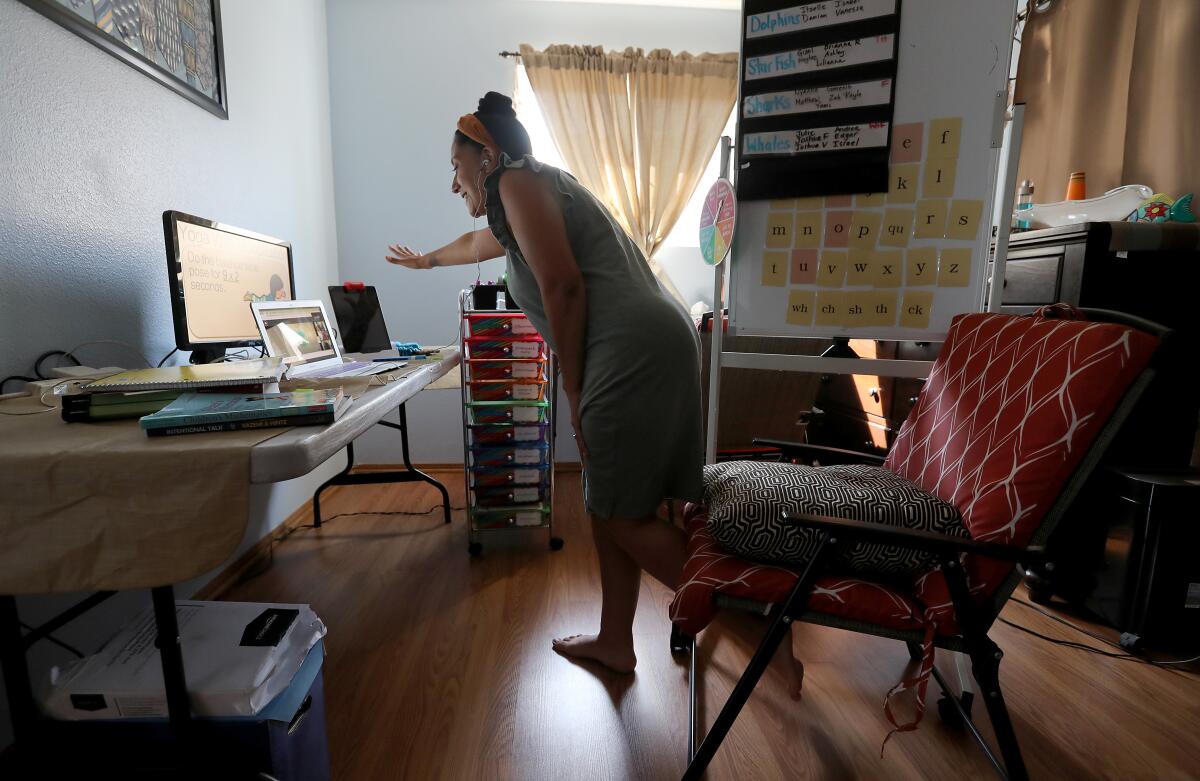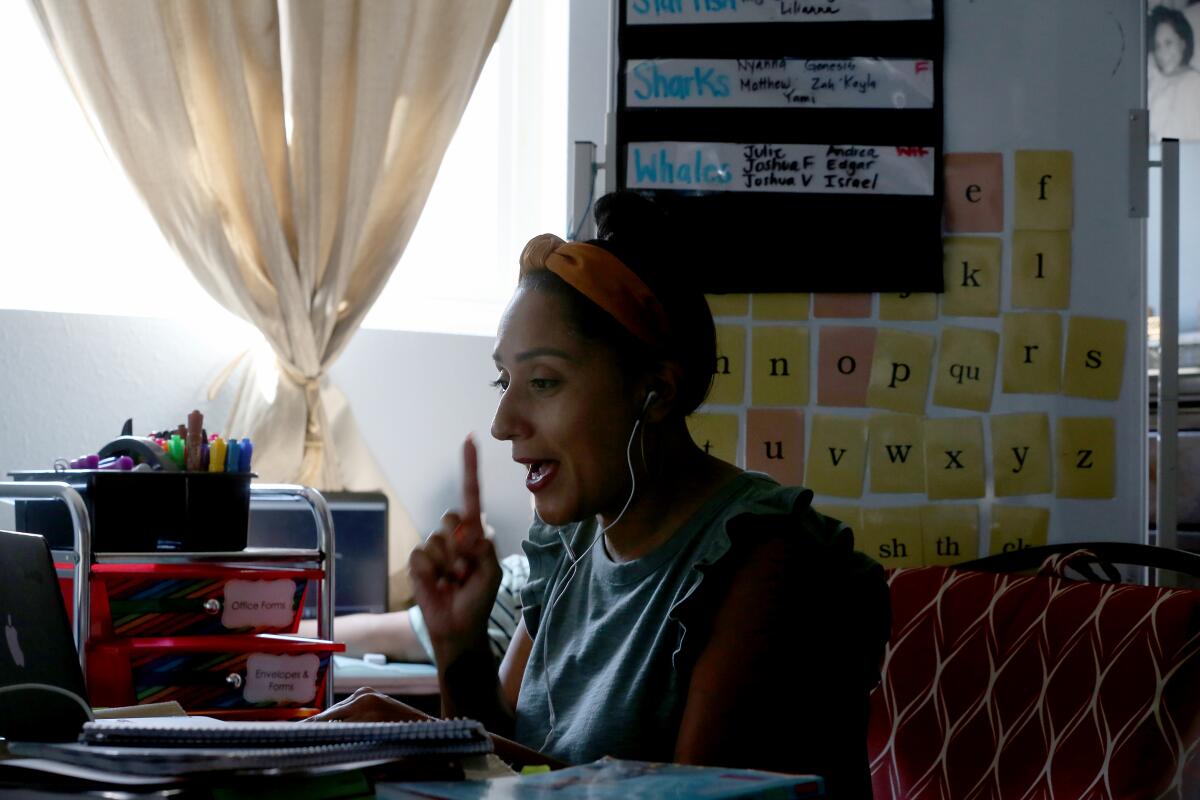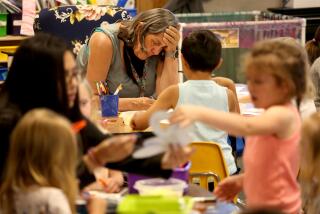These educators show what it takes to be named ‘teacher of the year’ amid a pandemic

- Share via
Rhiannon Chavez has always been an animated teacher, and her fourth-grade classroom is her theater. She sings, dances and gesticulates during her lessons, engaging her 23 students at 186th Street Elementary School in Gardena.
But distance learning has elevated these tactics to a whole new level.
Now, as she teaches into a computer screen from her home in San Pedro, she pours every last bit of energy into making sure that her enthusiasm is infectious enough to span the digital divide. From one of her three computer monitors screens she leads the children in a song about rounding numbers, her hand movements and facial expressions are bigger and more spirited than ever.
“After I log off, I’m exhausted,” said Chavez, who’s taught for 16 years. “I feel like I’ve just worked out for hours.”
Chavez, who works for L.A. Unified, is one of 10 educators who were named a Los Angeles County teacher of the year on Thursday. Though most were nominated by their schools before the pandemic even hit, their outstanding skills have been put to task since March, when schools were shut down and they were forced to adapt to distance learning overnight.
Their experiences illustrate how even the best are mightily challenged during this crisis in education.
Across the board, the teachers said that maintaining a connection with students through a screen — though not impossible — has been their biggest hurdle.

“The hardest part of all this is not being there physically with my students — not being able to greet them at the door, give them high fives and fist bumps,” said Ericca Dent, a second-grade teacher at Joaquin Miller Elementary School in Burbank Unified School District.
In the classroom, it’s easy enough for Dent to know whether a student is struggling with the material or isn’t feeling well. She can gently pull them to the side and check in. But it’s hard to pick up on these cues through a computer screen.
During one recent Zoom session, Dent noticed that a student was crying.
“I wanted to know what’s going on but don’t want to embarrass him or draw attention to the rest of the class,” she said. “It was heartbreaking.”
Timothy Green teaches specialized classes in firefighting and emergency medicine at Highland High School in Antelope Valley Union High School District. Most of his students are aspiring doctors, paramedics and police officers. By this point in the school year, Green would usually be teaching students how to secure tools with ropes and how to use a hose to apply and spray water. When someone needed help with a knot, he could hop over and help.
Now, he’s doing his best to teach some of these highly tactile lessons through a computer screen.
“I’m finding that some students don’t interact as much because they feel everyone is watching them,” he said. “We’re all in this ‘Brady Bunch’ grid view, and kids are self-conscious.”
Hazel Kight Witham, an English teacher at Venice High School with L.A. Unified, said an increasing number of students are “drifting”; they’re logged on but have their cameras off. This is usually a tech issue, she said; Chromebooks have a stronger connection if the webcam isn’t being used.
“We spend a whole lot of time muted,” Kight Witham said. “When we’re back in the classroom, I don’t know if I’m ever going to ask them to be quiet again.”
With the lack of in-person interaction and the everyday pressures of the pandemic, these teachers are deliberate about checking in with students.
As her second-graders log on in the morning, Dent asks them how they’re feeling, feedback they provide through a thumbs up or thumbs down.
“I usually have a good three to four kids who have their thumbs down,” she said.
Every Monday morning, Green asks his students how their weekend went and shares a bit about his own.
“A teacher has to be very self-aware, really pursue students, and has to really work hard to make sure inclusion happens for all kids right now,” he said.
Kight Witham is leading students in a “happiness challenge” meant to reset their minds for greater positivity. For 21 days straight, they’ve been asked to exercise, meditate, journal and list what they’re grateful for.
The project has provided an entry-point for deeper conversations about their emotional health. One student messaged Kight Witham privately on Zoom to say that she had nothing positive to share. “It’s just so hard,” she said.
Working in small groups of five or so students — or breakout rooms, as they’re called in Zoom — has helped teachers to get to know their pupils, most of whom they’ve never met in person.
These teachers are also placing an extra emphasis on games and having fun. Breaks are far more common across all grades. When Dent sees her students start to fade, they dance, stretch or do jumping jacks for 10 minutes.
In the supply bags that her fourth-graders picked up before school started, Chavez placed a kazoo and a laminated bitmoji — an animated avatar — of herself in their pencil cases.
“I wanted to know that even though I can’t be with them physically, Little Ms. Chavez is always there when you need her,” she said. One student taped the bitmoji to his bedpost, next to where he works.
Students get to blow the kazoo when there’s perfect attendance or when a student who’s usually late shows up on time.
Dan Calma, a teacher at DD Johnston Elementary School in Norwalk-La Mirada Unified School District, plays games with his third-graders to get them used to the technology.
“I’ll ask a question, and if it pertains to them they’ll turn on their video so everybody can see them,” he said.
By all accounts, the pandemic has made these veteran teachers work twice, three times as hard. They spend many hours talking to stressed-out parents by phone and email, and adapting lessons they’ve honed over decades to online learning.
But L.A. County’s teachers of the year — who receive $1,000 and a $350 gift certificate for school supplies at Lakeshore Learning — say it’s worth it.
“This whole situation has definitely made me think outside the box and really be creative,” Dent said. “This is not what we want to be doing, but the kids still deserve the best possible education I can give them.”
One of the most rewarding moments for Chavez was when, ahead of a three-day weekend, a student asked if he could log onto Zoom on Monday and say hi to the class, anyway.
“Through all the challenges and the sleepless nights and wondering when we’ll get back, just that comment right there made me realize I’m doing a good job,” she said. “The kids want to be there.”
More to Read
Sign up for Essential California
The most important California stories and recommendations in your inbox every morning.
You may occasionally receive promotional content from the Los Angeles Times.











